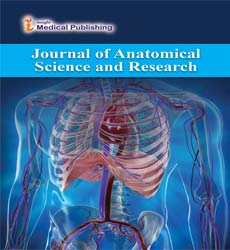Various Kinds of Muscle Tissue
Malak A. Alghamdi*
Department of Anatomy, Howard University College of Medicine, Washington, DC, USA
- *Corresponding Author:
- Alghamdi MA
Department of Anatomy
Howard University College of Medicine
Washington, DC, USA
Tel: 2085608447
Email: m.alghamdi@bison.howard.edu
Received Date: November 06, 2020 Accepted Date: November 20, 2020 Published Date: November 27, 2020
Citation: Alghamdi M (2020) Various kinds of Muscle Tissue. J Anat Sci Res Vol.3 No.2:e002
Abstract
A muscle is a band or a bundle of fibrous tissue in a human or animal body that can contract, producing movement in or maintaining the position of parts of the body. Muscles make up the majority of the body and account for 1/3rd of its weight. Blood vessels and nerves run to every muscle, helping control and manage each muscle's function.
Keywords
Musculoskeletal system; Joint; Cartilage; Ligaments; Tendons; Voluntary muscle; Involuntary muscle; Striated muscle
Editorial Note
Muscle tissue
The body has three fundamental types of muscle tissue
• Skeletal
• Smooth
• Cardiac
Muscle structure: Skeletal (striated or deliberate) muscle comprises of densely packed groups of massively extended cells known as myofibers. These are gathered into packs (fascicles). A typical myofiber is 2–3 cm long and 0.05 mm in width and is composed of narrower structures–myofibrils. These contain thick and thin myofilaments made up basically of the proteins, actin and myosin. Various vessels keep the muscle supplied with the oxygen and glucose needed to fuel contraction [1].
Skeletal muscle: Skeletal muscles attach to bone by tendons (connective tissue) and enable movement. Skeletal muscles are mostly voluntary.
The typical male body contains approximately 640 muscles, which make around two-fifths of its weight. The same number in a female body make up a slightly smaller proportion. A normal muscle spans a joint and tapers at each end into a fibrous tendon anchored to a bone. Few muscles divide to attach to different bones [2,3].
Tendons: These are tough, fibrous cords of connective tissue that link skeletal muscles to bones. Inside them, Sharpey's filaments go through the bone covering (periosteum) to insert in the bone. Tendons in the hands and feet are enclosed in selflubricating sheaths to protect them from running against the bones. From the hand bones, tendons extend upwards to muscles near the elbow.
Smooth muscle: This is the second kind of muscle present in the walls of body parts, such as the stomach, alimentary canal, and blood vessels. This is called involuntary muscle, since it works naturally instead of conscious control. From its magnified appearance, it moves food through digestive organs, empties liquid from the bladder and controls width of the blood vessels. Smooth muscle lines organs and is involuntary. Smooth muscle around the artery allows the artery to regulate blood flow by contracting and expanding [3].
Cardiac muscle: This is the third type of muscle that makes up the walls of the heart. It is a part of both the Muscular System and the Circulatory System. It is responsible for circulating blood all through the body. It has its own pacemaker for rhythmic beating. The heart wall is made up of three layers. The middle layer, the myocardium, is responsible for the heart's pumping action. Cardiac muscle found only in the myocardium, contracts in response to signals from the cardiac conduction system to make the heartbeat. It is made from cells called cardiocytes. This muscle is present only in the heart, pumps blood throughout body and contains more mitochondria than skeletal muscle cells [1].
How do Skeletal Muscles Move?
It happens when the muscular system and nervous system work together: Somatic signs are sent from the cerebral cortex to nerves associated with specific skeletal muscles. Most signals travel through spinal nerves that connect with nerves that innervate skeletal muscles all through the body. Muscle contraction begins with the nervous system generates a signal. The signal, an impulse called an action potential, travels through a type of nerve cell called a motor neuron. The neuromuscular junction is the name of the place where the motor neuron reaches a muscle cell [4].
Skeletal muscle tissue is composed of cells called muscle fibers. The brain neuron sends electronic signals to the motor neuron. When the nervous system signal reaches at the neuromuscular junction a chemical message is released by the motor neuron. The chemical message, a neurotransmitter called acetylcholine, binds to receptors on the outside of the muscle fiber. This starts a chemical reaction in the muscle, to make it contract. A multistep molecular process within the muscle fiber starts when acetylcholine binds to receptors on the muscle fiber membrane. The proteins inside muscle fibers are organized into long chains that can collaborate with each other, reorganizing to shorten and relax. When acetylcholine reaches receptors on the membranes of muscle fibers, membrane channels open and the cycle that contracts a relaxed muscle fiber begins. When the stimulation of the motor neuron giving the impulse to the muscle fibers stops, the chemical reaction that causes the rearrangement of the muscle fibers proteins is stopped. This reverses the chemical process in the muscle fibers and the muscle relaxes.
References
- Aziz MA (1981) Possible ‘atavistic’ structures in human aneuploids. Am J Phys Anthropol 54: 347-353.
- Gasser RF (1967) The development of the facial muscles in man. American J Anat 120: 357-375.
- Turgut HB, Peker T, Gülekon N, Anil A, Karaköse M (2005) Axillopectoral muscle (langer’s muscle). Clin Anat 18: 220-223.
- Bonastre V, Rodríguez-Niedenführ M, Choi D, Sañudo JR (2002) Coexistence of a pectoralis quartus muscle and an unusual axillary arch: Case report and review. Clin Anat 15: 366-370.
Open Access Journals
- Aquaculture & Veterinary Science
- Chemistry & Chemical Sciences
- Clinical Sciences
- Engineering
- General Science
- Genetics & Molecular Biology
- Health Care & Nursing
- Immunology & Microbiology
- Materials Science
- Mathematics & Physics
- Medical Sciences
- Neurology & Psychiatry
- Oncology & Cancer Science
- Pharmaceutical Sciences
